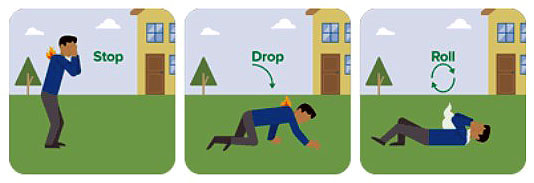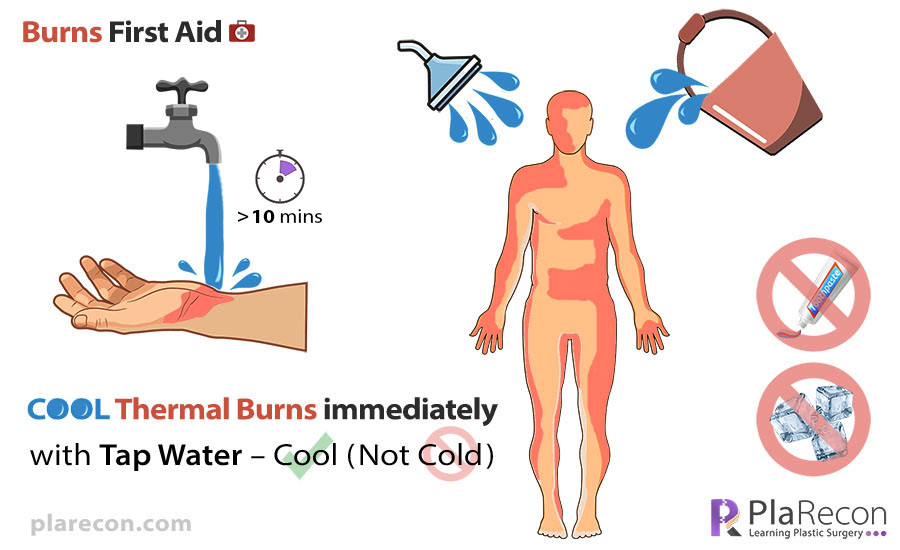About 6-7 million people sustain burns every year in India, i.e. about 3-5 every minute. Proper and timely first aid immediately after burns is very effective in lowering the intensity of damage in these people. Not only can these few essential steps (mentioned below) save many lives, they may also prevent debilitating post-burn deformities in millions of burns victims.
First aid in Thermal Burns
1. “STOP THE BURNS”:
(a) Instruct to follow “Stop, Drop, Roll” manoeuvre if active flames are present:
- STOP movement- prevents fanning of the fire and hampering fire fighting efforts by others,
- DROP to the ground and keep lying as long as possible coving the face to prevent facial burns,
- ROLL on the ground or roll a rug nearby around to extinguish flames on clothes [deprives flame of oxygen].
-OR- (b) Use fire extinguisher or sand or water to douse the flames and evacuate the patient from the fire site.
2. Look for pulses and breathing. If absent, start CPR (Cardiopulmonary Resuscitation) immediately and shift to nearest Emergency or Burns centre. [Also, cover the patient and lift the limb(s) with burns above heart level if possible, to prevent shock.]
3. Remove the burnt clothes. Cut around the parts of the clothing stuck to the burnt skin.
4. COOL THE BURN WOUND under running cool tap water (NOT COLD, NOT ICE) or by cool compress (best: within 20 mins) until the burning sensation subsides. [Important step]
[Reasons: Cooling stabilizes mast cells in the skin→ decreases histamine release→ reduces edema of the thermal burn areas. Cold water or ice, however, causes vasoconstriction in skin and increases the damage (depth) of burns.]
Caution: For large areas of burns, avoid prolonged lavage with cool water and do not immerse the burnt parts in cold water. [Reason: May lead to hypothermia→ sepsis.] For such extensive areas, after cooling with cool water as above, cover the patient immediately.
5. Cover with sterile roller gauze, clean sheet of cloth or clean plastic sheet (as available) to keep patient warm and reduce pain (esp. in large burns). Avoid direct contact with woollens or cotton. [Reason: Irritates and sticks to the burnt skin]
6. Remove any constrictive dress or object like a ring, belt, thread or ornament. [Reason: Burnt areas swell fast (burns edema) and these circumferentially applied objects may constrict and affect blood supply distally.]
7. Do not apply any local agents (eg. toothpaste, turmeric powder, mercurochrome) or ointments (esp. coloured ones) on the burn wounds, especially in large burns. [Reason: Interferes with the evaluation of burn depth and extent, later in burns centre.]
8. Do not do anything to the blisters yet. [Reason: they provide biological dressing over the burnt surface, decrease pain and prevent infection.] In burns centre, they may be removed in large burns for depth assessment and cleansing under sterile conditions.
First aid in Electrical Burns
Watch out! It may cause more harm to the rescuer than the victim. Look before you leap to help and do the below first:
1. STOP THE BURNS:
- Switch off the electrical mains or source or electricity (if possible).
- If electric supply can’t be shut, break the contact between the victim and the electric supply (wire, etc.) using a non-conductive object (eg. wooden, plastic, cardboard or rubber).
Caution: Do not touch the victim with bare hands or iron rod [Reason: Electricity may conduct through rescuer’s hands and cause electrical burns which may (esp. in high voltage burns) lead to amputations and even loss of life.]
Then: Follow steps 2-8 of first aid in thermal burns above.
Caution: Do not pour water as water conducts electricity and may electrocute more people. However, water can be used to cool the areas of burn due to electric flash but only after evacuating the victim away from the source of electricity.
First aid in Chemical Burns
1. STOP THE BURNS (limit exposure) by removal of the contact of the causal agent from the patient.
This can be achieved by:
- Removal of contaminated clothing,
- Prolonged, copious but gentle irrigation with water (shower/ pour) over the affected sites (including eyes- if involved). [Important step] Irrigation should be continued till the burning sensation subsides (often takes 30 minutes to 2 hours).
Caution (during irrigation):
- Do not irrigate the patient in a tub. [Reason: it restricts the causal agent to the tub and thus increases contact.]
- The first aid provider should be well protected to prevent additional injuries from the offending agent.
- Preferably use mildly warm (lukewarm) lavage for larger areas. Do not use ice or cold water. [Reason: Large volume of irrigation puts the patient at potential risk of hypothermia due to evaporation.]
Then: follow steps 5-8 of first aid in thermal burns above.
First aid in Radiation Burns
1. Firstly, STOP THE BURNS(limit exposure) by evacuating the patient from the source of radiation.
Rest all is same as in the case of Chemical burns (above).
What Next?
Most of the minor, superficial burns can be managed in the home or local clinic while major burns (large area); deeper burns; and electrical/ chemical/ radiation + inhalational burns; burns in children or elderly with comorbidities require specialized care provided by Plastic surgeons in Burns units and need to be shited to the same at the earliest. More details in subsequent posts.
So, the most effective way to lessen damage from most burns except electrical is to POUR WATER.
But, what’s better is to PREVENT IT in the first place.
Stay tuned for posts on the preventive measures in burns (esp. in children). If you found the post useful, do share with friends and relatives and stay safe.
References (For further reading):
- Rajan V, Bartlett N, Harvey JG, et al. Delayed cooling of an acute scald contact burn injury in a porcine model: is it worthwhile? J Burn Care Res. 2009;30(4):729-734.
- Book: Principles and Practice of Burn Care- Sujata Sarabahi.
- Book: Total Burn Care- Herndon.

Tutorials & tips in Plastic Surgery
+ Weekly updates of high-quality webinars!





